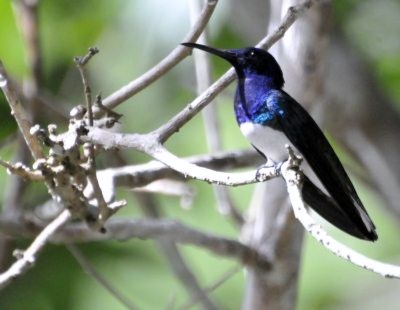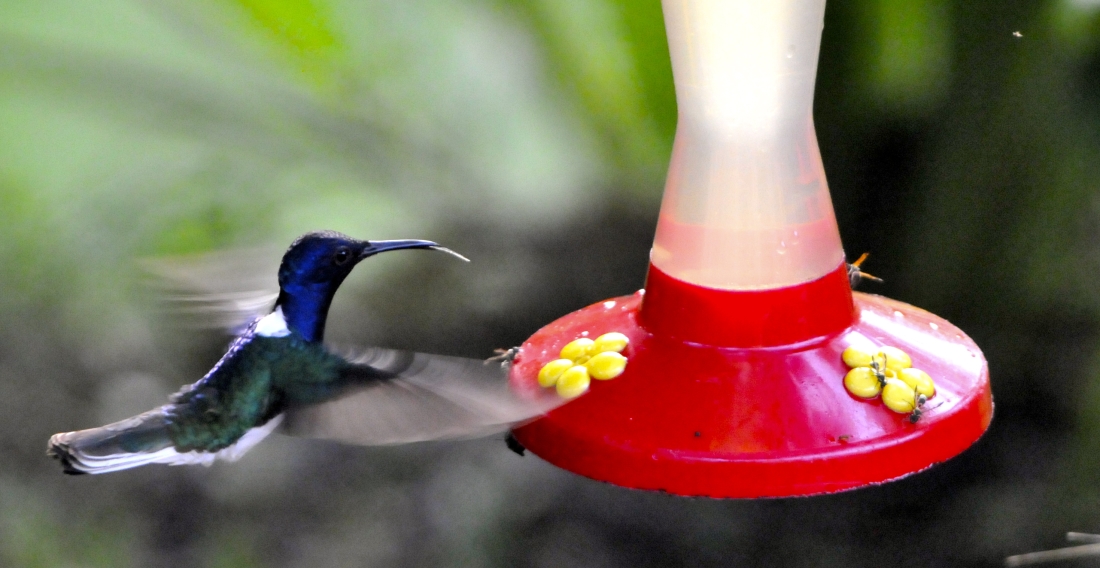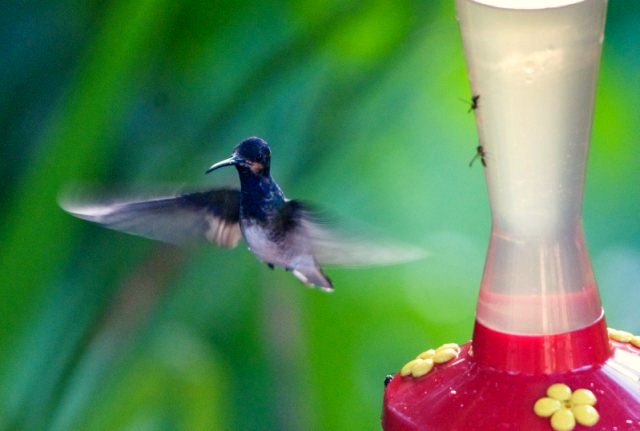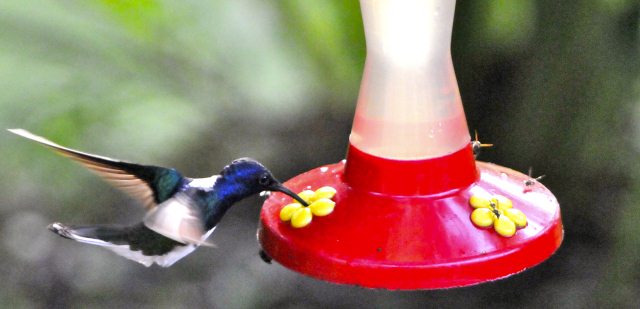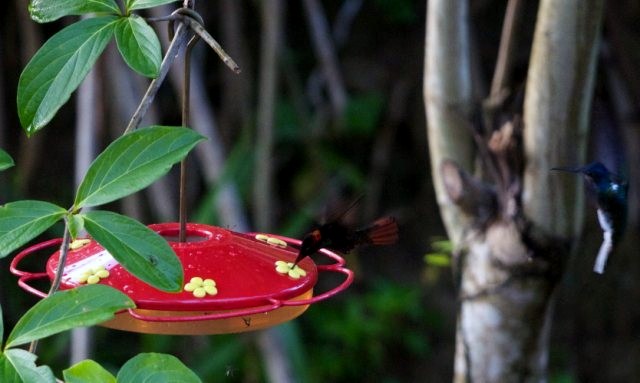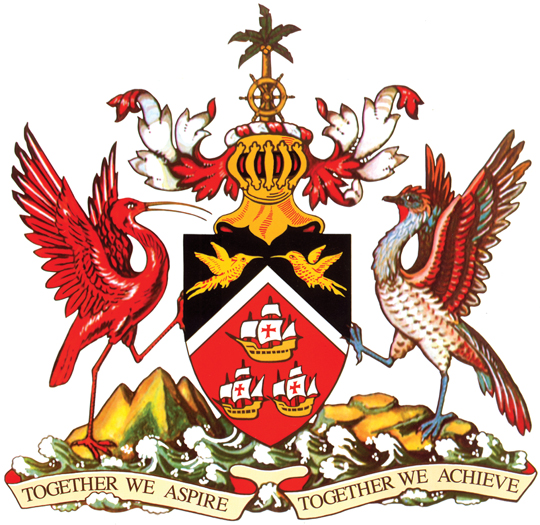|
Hummingbirds
We saw so many White-necked Jacobins at
Cuffie it made us want to know more about these fascinating little birds. For
some unknown reason this blogs layout has gone weird - tried seven times
adjusting and trying to make it right, but given up to get on with my life. Word
processor doing it's own thing, nothing to do with me, it looks perfect when it
it sent ???
Hummingbirds are birds comprising the family Trochilidae. They are
among the smallest birds and include the smallest extant bird species, the Bee
Hummingbird. They can
hover in mid-air by rapidly
flapping their wings twelve to ninety times per second (depending
on the species). They can fly backwards, the only group of birds able to do so.
Their English name derives from the characteristic hum made by their rapid wing beats. They can fly at
speeds exceeding thirty four miles per hour.
Diet:
Hummingbirds drink nectar, the sweet liquid inside flowers. Like bees, they
are able to assess the amount of sugar in the nectar they eat; they reject
flower types that produce nectar that is less than 10% sugar and prefer those
whose sugar content is stronger. Nectar is a poor source of
nutrients, so hummingbirds meet their
needs for protein, amino acids, vitamins, minerals, etc. by preying on insects and spiders, especially when feeding young. Most hummingbirds
have bills that are long and straight or nearly so, but in some species the bill
shape is adapted for specialized feeding. Thornbills have short, sharp bills adapted for feeding from
flowers with short corollas and piercing the bases of longer ones. The
Sicklebills' extremely decurved bills are adapted to extracting nectar from the
curved corollas of flowers in the family Gesneriaceae. The bill of the Fiery-tailed
Awlbill has an upturned tip, as in
the Avocets. The male Tooth-billed
Hummingbird has barracuda-like spikes
at the tip of its long, straight bill. The two halves of a hummingbird's bill
have a pronounced overlap, with the lower half
(mandible) fitting tightly inside the upper half
(maxilla). When hummingbirds feed on nectar, the bill is
usually only opened slightly, allowing the tongue to dart out and into the
interior of flowers. Like the similar nectar-feeding
sunbirds and unlike other birds, hummingbirds drink by using
protrusible grooved or trough-like tongues. Hummingbirds do not spend all day
flying, as the energy cost would be prohibitive; the majority of their activity
consists simply of sitting or perching. Hummingbirds feed in many small meals,
consuming many small invertebrates and up to five times their own body weight in
nectar each day. They spend an average of 10–15% of their time feeding and
75–80% sitting and digesting.
A huge thrill to get a shot of this little chap 'licking his lips'
Co-evolution with ornithophilous flowers:
Hummingbirds are specialized
nectarivores and are tied to the
ornithophilous flowers they feed upon.
Some species, especially those with unusual bill shapes such as the Sword-billed
Hummingbird and the sicklebills, are
co-evolved with a small number of
flower species. Many plants pollinated by hummingbirds produce flowers in shades
of red, orange and bright pink, though the birds will take nectar from flowers of
many colours. Hummingbirds can see wavelengths into the near-ultraviolet, but their flowers do not reflect these wavelengths
as many insect-pollinated flowers do. This narrow colour
spectrum may render
hummingbird-pollinated flowers relatively inconspicuous to most insects, thereby
reducing nectar robbing. Hummingbird-pollinated flowers also produce
relatively weak nectar (averaging 25% sugars w/w) containing high concentrations
of sucrose, whereas insect-pollinated
flowers typically produce more concentrated nectars dominated by fructose and
glucose.
 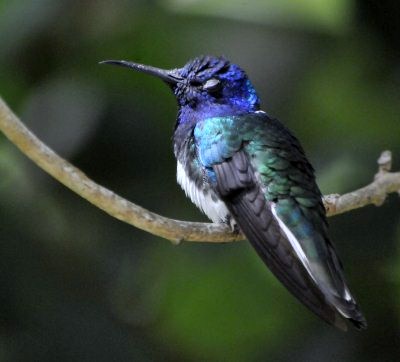
Awake and catchin' forty
winks
Aerodynamics of flight:
Hummingbird flight has been studied intensively from an
aerodynamic perspective using wind
tunnels and high-speed video cameras. Writing in Nature, the biomechanist Douglas
Warrick and coworkers studied the Rufous
Hummingbird, Selasphorus rufus, in a
wind tunnel using particle image
velocimetry techniques and investigated
the lift generated on the bird's upstroke and downstroke. They concluded that
their subjects produced 75% of their weight support during the downstroke and
25% during the upstroke. Many earlier studies had assumed (implicitly or
explicitly) that lift was generated equally during the two phases of the
wingbeat cycle, as is the case of insects of a similar size. This finding shows
that hummingbirds' hovering is similar to, but distinct from, that of hovering
insects such as the hawk moths. The Giant Hummingbird's wings beat at eight to ten
beats per second, the wings of medium-sized hummingbirds beat about twenty to
twenty five beats per second and the smallest can reach one hundred beats per
second during courtship displays.
Metabolism:
With the exception of insects, hummingbirds while in flight
have the highest metabolism of all animals, a necessity in order to support the
rapid beating of their wings. Their heart rate can reach as high as 1,260 beats per minute, a rate
once measured in a Blue-throated Hummingbird. They also consume more than their own weight in
nectar each day, and to do so they must visit hundreds of flowers daily.
Hummingbirds are continuously hours away from starving to death, and are able to
store just enough energy to survive overnight. Hummingbirds are capable of
slowing down their metabolism at night, or any other time food is not readily
available. They enter a hibernation-like state known as torpor. Something Bear is getting more expert at by the
day. During torpor, the heart rate and rate of breathing are both slowed
dramatically (the heart rate to roughly fifty to one hundred and eighty beats
per minute), reducing the need for food - oh, Bear hasn't got to that part of
the manual yet then. The dynamic range of metabolic rates in hummingbirds
requires a corresponding dynamic range in kidney function. The
glomerulus is a cluster of capillaries
in the nephrons of the kidney that removes
certain substances from the blood, like a filtration mechanism. The rate at
which blood is processed is called the glomerular filtration rate (GFR). Most
often these fluids are reabsorbed by the kidneys. During torpor, to prevent
dehydration, the GFR slows, preserving necessities for the body such as glucose,
water and salts. GFR also slows when a bird is undergoing water deprivation. The
interruption of GFR is a survival and physiological mechanism unique to
hummingbirds. Studies of hummingbirds' metabolisms are highly relevant to the
question of how a migrating Ruby-throated Hummingbird can cross five hundred miles of the Gulf of
Mexico on a nonstop flight, as
field observations suggest it does. This hummingbird, like other birds preparing
to migrate, stores up fat to serve as fuel, thereby augmenting its weight by as
much as 100% and hence increasing the bird's potential flying
time.
Lifespan:
Hummingbirds have long lifespans for organisms with such rapid
metabolisms. Though many die during their first year of life, especially in the
vulnerable period between hatching and leaving the nest, those that survive may
live a decade or more. Among the better-known North American species, the
average lifespan is three to five years. By comparison, the smaller
shrews, among the smallest of all
mammals, seldom live more than two years. The longest recorded lifespan in the
wild is that of a female Broad-tailed Hummingbird that was ringed as an adult at
least one year old then recaptured eleven years later.
A rare glimpse for us of the Rufous-tailed Hummingbird, the Jacobin waits patiently in
line
Range:
Hummingbirds are restricted to the
Americas, from southern
Alaska to Tierra del
Fuego, including the
Caribbean. The majority of species
occur in tropical and subtropical Central and South
America, but several species also breed in temperate
climates and some hillstars even occur in alpine Andean highlands at altitudes of up to seventeen thousand,
one hundred feet. The greatest species richness is in humid tropical and subtropical forests of the
northern Andes and adjacent foothills, but the number of species found in the
Atlantic Forest, Central America or
southern Mexico also far exceeds the number
found in southern South America, the Caribbean islands, the US and
Canada. About twenty five
different species of hummingbirds have been recorded in the US, less than ten
from Canada and the same number for Chile. Colombia alone has more than one hundred and sixty and the
comparably tiny Ecuador has about one hundred and thirty species. The
Rufous Hummingbird is one of several species that breed in western North America
and are wintering in increasing numbers in the southeastern US, rather than in
tropical Mexico. Thanks in part to artificial feeders and winter-blooming
gardens, hummingbirds formerly considered doomed by faulty navigational
instincts are surviving northern winters and even returning to the same gardens
year after year. Individuals that survive winters in the north, however, may
have altered internal navigation instincts that could be passed on to their
offspring. The Rufous Hummingbird nests farther north than any other species and
must tolerate temperatures below freezing on its breeding grounds. This cold
hardiness enables it to survive temperatures well below freezing, provided that
adequate shelter and feeders are available.
Hummingbird canvas. A colour plate illustration from Ernst Haeckel's Kunformen
der Natur 1899
Reproduction:
As far as is known, male hummingbirds do not take part in nesting.
Most species build a cup-shaped nest on the branch of a tree or shrub, though a
few tropical species normally attach their nests to leaves. The nest varies in
size relative to species, from smaller than half of a
walnut shell to several
centimeters in diameter. In many hummingbird species, spider silk is used to
bind the nest material together and secure the structure to its support. The
unique properties of silk allow the nest to expand with the growing young. Two
white eggs are laid, which, despite being the smallest of all bird eggs, are in
fact large relative to the hummingbird's adult size.
Incubation lasts fifteen to nineteen
days, depending on species, ambient temperature, and female attentiveness to the
nest. Their mother feeds the nestlings on small
arthropods and nectar by inserting her
bill into the open mouth of a nestling and regurgitating the food into its
crop.
Systematics:
There are between three hundred and twenty five to three
hundred and forty species of hummingbird, depending on taxonomic viewpoint,
historically divided into two subfamilies, the hermits (subfamily Phaethornithinae, thirty four species in six genera), and the
typical hummingbirds (subfamily Trochilinae, all the others).
One of the Nazca Lines in Peru, depicts a
hummingbird. We hope to see this in September
Feeders and artificial nectar:
Hummingbirds will either hover or perch to feed; red feeders
are preferred, but coloured liquid is not necessary and may be hazardous to
their health. Hummingbirds will also take sugar-water from
bird-feeders. Such feeders allow people
to observe and enjoy hummingbirds up close while providing the birds with a
reliable source of energy, especially when flower blossoms are less abundant.
Only white granulated sugar is proven safe to use in hummingbird feeders. A
ratio of one cup sugar to four cups water is a common recipe. Boiling and then
cooling this mixture before use has been recommended to help deter the growth of
bacteria and yeasts. Powdered sugars contain corn starch as an anti-caking
agent; this additive can contribute to premature fermentation of the solution.
Brown, turbinado, and "raw" sugars contain iron, which can be deadly to hummingbirds if consumed
over long periods. Honey is made by bees from the nectar of flowers, but it contains sugars
that are less palatable to hummingbirds and promotes the growth of
microorganisms that may be dangerous to
their health. Red food dye is often added to homemade solutions. Commercial
products sold as "instant nectar" or "hummingbird food" may also contain
preservatives and/or artificial flavors
as well as dyes. The long-term effects of these additives on hummingbirds have
not been studied, but studies on laboratory animals indicate the potential to
cause disease and premature mortality at high consumption rates. Although some
commercial products contain small amounts of nutritional additives, hummingbirds
obtain all necessary nutrients from the insects they eat. This renders the added
nutrients unnecessary. Other animals also visit hummingbird feeders. Bees,
wasps and
ants are attracted to the
sugar-water and may crawl into the feeder, where they may become trapped and
drown. Orioles, woodpeckers, bananaquits, and other larger animals are known to drink from
hummingbird feeders, sometimes tipping them and draining the liquid. In the
southwestern United States, two species of nectar-drinking bats (Leptonycteris
yerbabuenae and Choeronycteris
mexicana) visit hummingbird feeders
to supplement their natural diet of nectar and pollen from
saguaro cacti and
agaves.
In myth and culture:
Aztecs wore hummingbird
talismans, the talismans being
representations as well as actual hummingbird fetishes formed from parts of real hummingbirds: emblematic
for their vigor, energy, and propensity to do work along with their sharp beaks
that mimic instruments of weaponry, bloodletting, penetration and intimacy.
Hummingbird talismans were prized as drawing sexual potency, energy, vigor and
skill at arms and warfare to the wearer. The Aztec
god Huitzilopochtli is often depicted as a hummingbird. The
Nahuatl word huitzil (hummingbird)
is an onomatopoeic word derived from the
sounds of the hummingbird's wing-beats and zooming
flight. The Ohlone tells the story of how Hummingbird brought fire to
the world. Trinidad and Tobago is known as "The land of the hummingbird," and a
hummingbird can be seen on that nation's coat of
arms and 1-cent coin as well as
its national airline, Caribbean
Airlines.
ALL IN ALL AN INCREDIBLE LITTLE BIRD
THE MOST UNIQUE BIRD ON THE PLANET,
BEAUTIFUL
|

